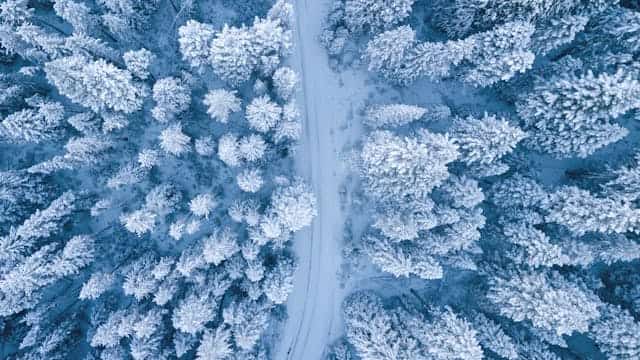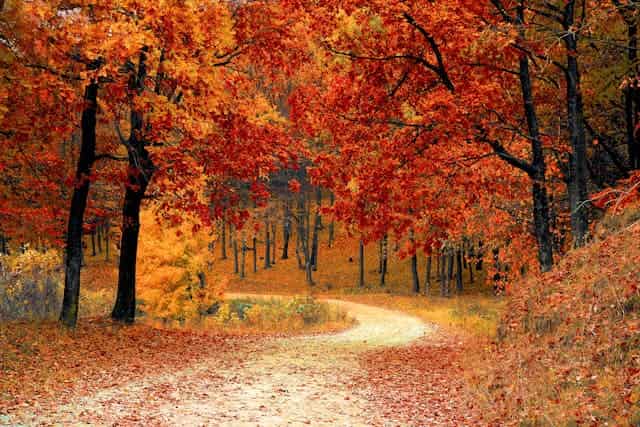Winter and autumn are among the four seasons in the Northern Hemisphere, with the latter coming before the former. The four main seasons in the northern hemisphere are spring, summer, autumn, and winter, with each season lasting for four months.
These four seasons occur as a result of the revolution of the Earth. Autumn and winter last for about eight months or more. Some regions in the northern hemisphere experience heavy snowfall during the early days of spring.
Autumn comes towards the last quarter of the year when the sun returns to the equator. Winter begins in the last month of the year lasting through the first quarter of the following year.
Both seasons are experienced by the North Temperate Zone. Those who live close to the equator do not experience autumn and winter seasons.
If you are wondering if there is a difference between winter vs autumn, continue reading this guide to know more.

Winter
Winter is the season after autumn when the northern hemisphere gets the least amount of sunlight a day. It’s the coldest and darkest season of the year when the hemisphere is oriented away from the Sun.
Autumn comes before winter and spring comes after winter. Generally, the winter season begins on December 21st or 22nd, lasting through the first quarter of the following year.
Other cultures around the world have different dates as the beginning of winter. December 21st or 22nd is the winter solstice and the day of the year with the shortest period of daylight.
Seasons occur differently in the northern hemisphere and southern hemisphere. When regions in the northern hemisphere are buried in inches of snow during winter, its summer in the southern hemisphere and vice versa.
The coldest and darkest season in the northern hemisphere usually brings precipitation, which is mainly rain or snow, depending on the region’s climate.
During winter, the Sun is at its farthest below the horizon from the North Pole. On the day the winter season begins, the days become shorter and nights become longer.
In winter, the earliest sunset and latest sunrise dates outside the northern hemisphere are different from the date of the winter solstice. This difference occurs as a result of the variation in the solar day throughout the year. This is caused by the planet’s elliptical orbit.
The term “winter” is derived from an Old Germanic word ‘wintar’ meaning “: time of water”. The Old Germanic word also refers to the rain and snow of winter.
Also Read: Mormons vs Catholics: Difference and Comparison

Autumn
Autumn is traditionally the third of the four seasons in the Northern Hemisphere. It’s the season before winter and after summer.
Also referred to as fall in American English, autumn is the season when deciduous trees lose their leaves.
Autumn occurs differently in the Northern Hemisphere and Southern Hemisphere. It begins from September 24 to December 22 in parts of the Northern Hemisphere, while it starts from March to May in the Southern Hemisphere.
Autumn is a season when daylight becomes shorter, with cooler temperatures compared to the season before it. During autumn, day length decreases, while night length increases.
Those in the Northern Hemisphere will continue to experience shorter daytime and longer nighttime until the winter solstice in December. People living in the Southern Hemisphere will have the same experience until the winter solstice in June.
Also Read: Middle Ages vs Medieval Ages: Difference and Comparison
Winter vs Autumn: Key Differences between Winter and Autumn
Winter and autumn are two of the four seasons that occur in the Northern Hemisphere and Southern Hemisphere. Winter is the coldest season that lasts from December 21st or 22nd through the first quarter of the following year in the Northern Hemisphere and from June to August in the Southern Hemisphere.
Some regions in the Northern Hemisphere experience the heaviest snowfall in early January. Winter in some parts of the Northern Hemisphere lasts through April.
Some countries remain in freezing temperatures even in the early days of spring.
Autumn is the season before winter and after summer in both the Northern Hemisphere and Southern Hemisphere.
Days usually become shorter and nights become longer during autumn. It’s a season where the temperature gradually becomes colder after months of hot summer.
Autumn is the season when deciduous trees lose their leaves. Day length decreases, while night length increases during the autumn season.
Winter vs Autumn: More Difference
The Northern Hemisphere get less sunlight during winter, with days significantly becoming shorter and nights becoming longer. This is because of the tilt of the Earth’s axis away from the sun in the respective hemisphere.
Autumn also comes with shorter days and longer nights. However, the season is also known for its balanced days and nights, mostly during the equinox. It starts from June to December 21st or 22nd.
Lots of activities come alive during winter. Fun activities such as snowboarding, ice skating, and skiing are mostly enjoyed during winter.
The season also brings out the creativity in sculptors. During winter, sculptors get creative by carving out statues from ice.
In Sweden, ice hotels are made using tons of saw-harvested blocks from the frozen River Torne. Ice villages are also made in places like Northern Japan.
In contrast, activities in autumn mainly involve apple picking, pumpkin carving, and lots more.
Autumn is the season that prepares people in the Northern and Southern Hemispheres for the coldest season of the year.
Also Read: Abraham Lincoln vs George Washington: Differences and Comparison
Winter vs Autumn: Comparison Chart
Here is a comparison chart highlighting the difference between winter vs autumn.
| Winter | Autumn (fall) | |
| Definition | The season after autumn, when the Northern Hemisphere and Southern Hemisphere get the least amount of sunlight a day. | Traditionally, the third of the four seasons in the Northern Hemisphere and the Southern Hemisphere. |
| Temperature | Cold, mainly below freezing in different regions. | Mild, cooling down from summer. |
| Usual activities | Snowboarding, ice skating, and skiing | Apple picking, and pumpkin carving, |
| Daylight | Shortest days, especially near the solstice | Decreasing daylight, balanced at the equinox |
| Cultural significance | Christmas and New Year | Harvest festivals and Thanksgiving |
| Environmental impact | Challenges for wildlife, migration and hibernation | Prepares people in the Northern and Southern Hemisphere for winter. |
Winter vs Autumn: Frequently Asked Questions
Below are frequently asked questions about the difference between winter and autumn.
What defines the beginning of winter?
Traditionally, the winter season begins on December 21st and 22nd. It begins at the winter solstice, which is the day with the least amount of daylight.
Also Read: Statue of Liberty vs Statue of Unity: Difference and Comparison
How do daylight hours change during winter compared to autumn?
The Northern Hemisphere get the shortest hours of daylight during winter, especially near the solstice, whereas autumn experiences a gradual decrease in daylight.
What are typical winter activities?
Lots of activities come alive during winter. Fun activities such as snowboarding, ice skating, and skiing are mostly enjoyed during winter.
What are the main characteristics of autumn?
The third of the four seasons in the Northern and Southern Hemisphere is characterized by cooling temperatures and changes in leaf colour.
How do animals adapt to the early days of winter after autumn?
Animals in the Northern Hemisphere prepare for the coldest season of the year by storing food, migrating or growing thicker fur.
Conclusion
Winter and autumn are two of the four seasons that occur in the Northern Hemisphere and Southern Hemisphere. They begin and last through different months of the year in the Northern and Southern Hemispheres.
People get creative during the months of winter, building ice hotels and sculptures. Autumn is also a season for some activities like apple picking, and pumpkin carvings.
Recommendations
- Valentine’s Day vs White Day: Differences and Comparison
- Northern Ireland vs Republic of Ireland: Difference and Comparison
- Mormons vs Catholics: Difference and Comparison
- Jehovah’s Witness vs Mormon: Difference and Comparison
- Joe Frazier vs Muhammad Ali: Difference and Comparison
References
- National Geographical: Season
- Wikipedia: Winter
- Wikipedia: Autumn

Leave a Reply